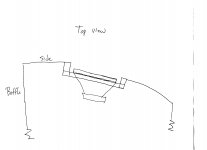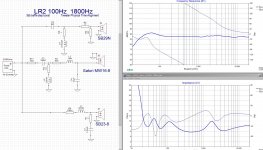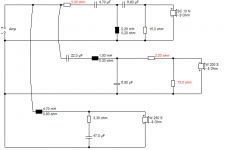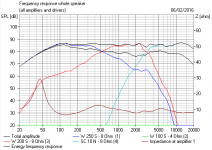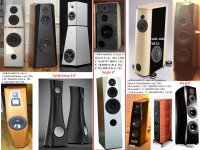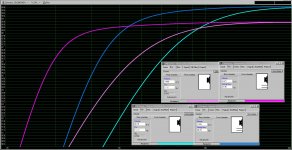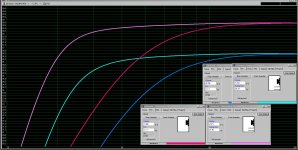Hello everyone,
I've been reading like crazy about this, but can't decide which way to go for a new 3-way design.
I want to make a pair of floor standing 3-ways next and of course WAF is the guiding line so they have to be quite thin, but I still want to have some lows, too. What I had in mind was WWMT setup with 2x8" like the RS225's.
But then what?
I'm thinking of two options:
a) The 2x8" going up to ~200 Hz, then a 6,5" (i.e. a Satori) up to ~2 000 Hz and then a tweeter in a waveguide.
This way the Satori would have quite a lot of the important range. This is maybe my favourite option so far.
or
b) The same 2x8" up to ~600 Hz, then a ~4,5 - 5" (i.e. a Visaton AL130) up to ~2 500 Hz or so and then the tweeter.
This way all of the lower range would have considerably more cone area, but can a single smaller driver keep up with the 8's and can the RS225's (or 8"s in general) handle everything up to 600 Hz or so? That would be a few octaves afterall.
MiniDSP would handle the 3-way active xovers and other signal processing duties and I have a 6 channel Rotel RB-976 or 3x stereo chipamps to run every channel.
I know that there are very good WWMTM's done with smaller mid range drivers like the Statements for example, but for visual reasons I have to stay with just one midrange, or in other words WWMT setup so that's why I wonder if I'd need to use a bigger single driver.
So please share your views of the pro's and con's of both options and which might sound better? Thanks!
I've been reading like crazy about this, but can't decide which way to go for a new 3-way design.
I want to make a pair of floor standing 3-ways next and of course WAF is the guiding line so they have to be quite thin, but I still want to have some lows, too. What I had in mind was WWMT setup with 2x8" like the RS225's.
But then what?
I'm thinking of two options:
a) The 2x8" going up to ~200 Hz, then a 6,5" (i.e. a Satori) up to ~2 000 Hz and then a tweeter in a waveguide.
This way the Satori would have quite a lot of the important range. This is maybe my favourite option so far.
or
b) The same 2x8" up to ~600 Hz, then a ~4,5 - 5" (i.e. a Visaton AL130) up to ~2 500 Hz or so and then the tweeter.
This way all of the lower range would have considerably more cone area, but can a single smaller driver keep up with the 8's and can the RS225's (or 8"s in general) handle everything up to 600 Hz or so? That would be a few octaves afterall.
MiniDSP would handle the 3-way active xovers and other signal processing duties and I have a 6 channel Rotel RB-976 or 3x stereo chipamps to run every channel.
I know that there are very good WWMTM's done with smaller mid range drivers like the Statements for example, but for visual reasons I have to stay with just one midrange, or in other words WWMT setup so that's why I wonder if I'd need to use a bigger single driver.
So please share your views of the pro's and con's of both options and which might sound better? Thanks!
If you need a slim face you could mount the 8"ers, one on either side, and mount a 5" and tweeter on the front.
Sorry I forgot to mention the curved cabinet. Can't mont anything to the sides or at least itwould make the construction tough. Originally I planned 10"ers to the sides, but the curved cabinets won the vote with clear numbers.

You could build a mounting flange that is tapered to the contour of the cabinet with a rebated baffle to mount the driver and mount it to the inside of the cabinet and cover with grille cloth.
That's true, but I'd rather stick with the looks that I have planned so far. Thanks, though.
Regarding the mid woofer size I've been wondering - what would be your opinion? Larger mid crossed lower or a smaller one crossed higher?
I'm not sure if this can be generalized the way I'm asking...
From B&W bass research: "One remarkable fact consistently noticed was that a single large and stiff bass cone always sounded better than a number of smaller cones, even though they may well have had the same aggregated properties. One possible explanation for this is the concept of the production of a “coherent wave front”.
So, DSP 3-way that uses just 3 GREAT speakers... Tweeter. Sealed Midrange. Sealed Woofer. Well designed sealed alignments produce superior transients without port "grunge".
The Santori 6" midrange, with low inductance motor, open-breathing rear, and controlled cone break-up, would be my choice over a smaller 4"-5". I favor one midbass covering the vocal range of 1.5Khz down to ~100Hz - 160Hz max. Male Bass vocals cover 80-160Hz. Female Soprano hits 1100Hz.
What is the largest woofer you can accept for your box design? Maybe fat bottom?
--single 8" will work for small rooms, but a 10" or 12" offers effortless dynamics.
Jeff Bagby selected the 10" SB29NRX-75 woofer crossed at 200Hz in the Kairos and Continuum Three-Ways.
===
The Power of God Compells You!
The Power of God Compells You!
The Power of God Compells You!
With a miniDSP and three amplifiers you can BEAT almost any speaker into producing good sound.
-Time alignment
-Optimized Crossovers
-Flat SPL
-Room Equalization
---BUT DSP is not the GOD FORCE, your design must still consider...edge diffraction, motor inductance "smear", lobing from large C-to-C separation, cone break-up in the passband, floor bounce, wall reflections.... the Devil is in the details.
So, DSP 3-way that uses just 3 GREAT speakers... Tweeter. Sealed Midrange. Sealed Woofer. Well designed sealed alignments produce superior transients without port "grunge".
The Santori 6" midrange, with low inductance motor, open-breathing rear, and controlled cone break-up, would be my choice over a smaller 4"-5". I favor one midbass covering the vocal range of 1.5Khz down to ~100Hz - 160Hz max. Male Bass vocals cover 80-160Hz. Female Soprano hits 1100Hz.
What is the largest woofer you can accept for your box design? Maybe fat bottom?
--single 8" will work for small rooms, but a 10" or 12" offers effortless dynamics.
Jeff Bagby selected the 10" SB29NRX-75 woofer crossed at 200Hz in the Kairos and Continuum Three-Ways.
===
The Power of God Compells You!
The Power of God Compells You!
The Power of God Compells You!
With a miniDSP and three amplifiers you can BEAT almost any speaker into producing good sound.
-Time alignment
-Optimized Crossovers
-Flat SPL
-Room Equalization
---BUT DSP is not the GOD FORCE, your design must still consider...edge diffraction, motor inductance "smear", lobing from large C-to-C separation, cone break-up in the passband, floor bounce, wall reflections.... the Devil is in the details.
Attachments
We had a question recently about using an 8" mid as a midrange.
I thought that was pretty daft considering the conventional wisdom says the mid should be somewhere in size between a big 8" bass and 1" tweeter. About 4".
SEAS-3-Way-Classic
Then I modelled it, and I found it actually worked rather well.
See the impedance correcting attenuator you can then use on the efficient 8" mid makes the filter work rather well.
So while you might consider 2X 6.5" SB Satoris as best used in an MTM or 2.5 way, the three way option might be superb! The third option.
I thought that was pretty daft considering the conventional wisdom says the mid should be somewhere in size between a big 8" bass and 1" tweeter. About 4".
SEAS-3-Way-Classic
Then I modelled it, and I found it actually worked rather well.
See the impedance correcting attenuator you can then use on the efficient 8" mid makes the filter work rather well.
So while you might consider 2X 6.5" SB Satoris as best used in an MTM or 2.5 way, the three way option might be superb! The third option.
Attachments
From B&W bass research: "One remarkable fact consistently noticed was that a single large and stiff bass cone always sounded better than a number of smaller cones, even though they may well have had the same aggregated properties. One possible explanation for this is the concept of the production of a “coherent wave front”.
So, DSP 3-way that uses just 3 GREAT speakers... Tweeter. Sealed Midrange. Sealed Woofer. Well designed sealed alignments produce superior transients without port "grunge".
The Santori 6" midrange, with low inductance motor, open-breathing rear, and controlled cone break-up, would be my choice over a smaller 4"-5". I favor one midbass covering the vocal range of 1.5Khz down to ~100Hz - 160Hz max. Male Bass vocals cover 80-160Hz. Female Soprano hits 1100Hz.
What is the largest woofer you can accept for your box design? Maybe fat bottom?
--single 8" will work for small rooms, but a 10" or 12" offers effortless dynamics.
Jeff Bagby selected the 10" SB29NRX-75 woofer crossed at 200Hz in the Kairos and Continuum Three-Ways.
===
The Power of God Compells You!
The Power of God Compells You!
The Power of God Compells You!
With a miniDSP and three amplifiers you can BEAT almost any speaker into producing good sound.
-Time alignment
-Optimized Crossovers
-Flat SPL
-Room Equalization
---BUT DSP is not the GOD FORCE, your design must still consider...edge diffraction, motor inductance "smear", lobing from large C-to-C separation, cone break-up in the passband, floor bounce, wall reflections.... the Devil is in the details.
Sadly, the largest driver I can fit is 8" or maybe, if I risk my life, 10". That's why I was thinking of using 2x8".
I'd have to build a new house first and then have the 15" bass I always wanted to...
What's motor inductance "smear"?
8" midrange can be irreplaceable but the ones that can sound good are mortgage class. However, using a standard EUR 50 class 8" midbass as a midrange gives good low mid dynamics, measure excellent and grants you very poor resolution.
I think Kimi has a good approach, but I would use an even larger midwoofer from the Satori line - they are released already - and use a crossover at around 2.6-3Khz. Vintage drivers can give you even more goods for the money but will cost more.
I think Kimi has a good approach, but I would use an even larger midwoofer from the Satori line - they are released already - and use a crossover at around 2.6-3Khz. Vintage drivers can give you even more goods for the money but will cost more.
Last edited:
Indefinitely prefer the first option with the waveguide and Satori although you can now get a 5" Satori too so perhaps also consider that. Visaton make a 5" waveguide if you're interested in going for the directivity match route.
Two RS225s per side will offer fantastic bass performance.
Two RS225s per side will offer fantastic bass performance.
Indefinitely prefer the first option with the waveguide and Satori although you can now get a 5" Satori too so perhaps also consider that. Visaton make a 5" waveguide if you're interested in going for the directivity match route.
Two RS225s per side will offer fantastic bass performance.
Thanks. It seems that the scales dip towards the bigger midrange.
I actually have the visaton 5" waveguide on a XT25. When I win the lottery I'll replace the XT25 with a Visaton KE 25 SC.
Curved side cabinets can be difficult to construct, and also reduce volume. Some designs provide artisic value from simple front baffle treatments like: large radius edges; beveled edges; mixing wood types; curved shapes. Flat panels of Baltic Birch are popular. Clever box dimensions plus bracing reduce resonances. Popular TM-WW cabinets like Sony SS-AR1 and Avalon EDGE use simple baffle edge cuts.
Attached a few 3-way box ideas to help discussion.
The 8" woofer SB23NRXS45-8 has a low inductance motor with Le=0.6mH, and no cone breakup until over 1Khz. With Fs=27Hz and Qtc=0.38 it models well in a ported box, and also in a sealed. The 6.5mm Xmax is average for an "articulate" woofer. Re= 5.6 ohms, so two wired in parallel to obtain 6db increase in SPL will have an amplifier load down to 2.8 ohms, or two small amps. Earlier passive crossover post showed Satori SPL match with SB23NRXS45.
Attached a few 3-way box ideas to help discussion.
The 8" woofer SB23NRXS45-8 has a low inductance motor with Le=0.6mH, and no cone breakup until over 1Khz. With Fs=27Hz and Qtc=0.38 it models well in a ported box, and also in a sealed. The 6.5mm Xmax is average for an "articulate" woofer. Re= 5.6 ohms, so two wired in parallel to obtain 6db increase in SPL will have an amplifier load down to 2.8 ohms, or two small amps. Earlier passive crossover post showed Satori SPL match with SB23NRXS45.
Attachments
Curved side cabinets can be difficult to construct, and also reduce volume. Some designs provide artisic value from simple front baffle treatments like: large radius edges; beveled edges; mixing wood types; curved shapes. Flat panels of Baltic Birch are popular. Clever box dimensions plus bracing reduce resonances. Popular TM-WW cabinets like Sony SS-AR1 and Avalon EDGE use simple baffle edge cuts.
Attached a few 3-way box ideas to help discussion.
The 8" woofer SB23NRXS45-8 has a low inductance motor with Le=0.6mH, and no cone breakup until over 1Khz. With Fs=27Hz and Qtc=0.38 it models well in a ported box, and also in a sealed. The 6.5mm Xmax is average for an "articulate" woofer. Re= 5.6 ohms, so two wired in parallel to obtain 6db increase in SPL will have an amplifier load down to 2.8 ohms, or two small amps. Earlier passive crossover post showed Satori SPL match with SB23NRXS45.
The Sony dual 8" is pretty much what I had in my mind. Curved sides make the speaker look smaller to my, and especially to my wife's, eye.
8" midrange can be irreplaceable but the ones that can sound good are mortgage class.
Hello Mario. I'd be interested in learning which 8" midranges you are thinking about. I've been looking for an 8" midrange to pair with a Beyma TPL but so far the front runners are 6.5", except maybe for PHL but sadly they don't publish SPL/impendance curves.
I had WinISD SPL plots for sealed and ported alignments for:
Dayton RS225_paper vs. SBacoustics SB23NRXS45
Dayton RS225_Aluminun vs. SBacoustics SB23NRXS45
1) All will perform well with a 100-300Hz crossover
2) As expected, independent SPL measurements show Dayton paper cone has less breakup over 1kHz than Aluminum cone
3) The SBacoustics SB23NRXS45 paper cone break-up becomes high above 2Khz.
In USA, Dayton ~$62, SBacoustics ~$92
Dayton RS225_paper vs. SBacoustics SB23NRXS45
Dayton RS225_Aluminun vs. SBacoustics SB23NRXS45
1) All will perform well with a 100-300Hz crossover
2) As expected, independent SPL measurements show Dayton paper cone has less breakup over 1kHz than Aluminum cone
3) The SBacoustics SB23NRXS45 paper cone break-up becomes high above 2Khz.
In USA, Dayton ~$62, SBacoustics ~$92
Attachments
This is an interesting thread. Few questions.
A 6" midrange capable of covering about 150Hz to 1.5KHz seem optimal in a 3way design.
Are there good tweeters that can crossover that low? How about directivity matching with the large cone area of the midrange?
BWM FST, Accuton, SB Satori seem like good candidates. Are there other good options?
in a 4-way, does it make sense to crossover to a 3" inch upper midrange covering from 1.2Khz to 4KHz and then a small tweeter higher up?
in a 3 or 4-way the bottom end seems similarly well served from 150Hz and down using 8",10" woofers.
A 6" midrange capable of covering about 150Hz to 1.5KHz seem optimal in a 3way design.
Are there good tweeters that can crossover that low? How about directivity matching with the large cone area of the midrange?
BWM FST, Accuton, SB Satori seem like good candidates. Are there other good options?
in a 4-way, does it make sense to crossover to a 3" inch upper midrange covering from 1.2Khz to 4KHz and then a small tweeter higher up?
in a 3 or 4-way the bottom end seems similarly well served from 150Hz and down using 8",10" woofers.
- Status
- This old topic is closed. If you want to reopen this topic, contact a moderator using the "Report Post" button.
- Home
- Loudspeakers
- Multi-Way
- Advice for which "type" of 3-way to build next
